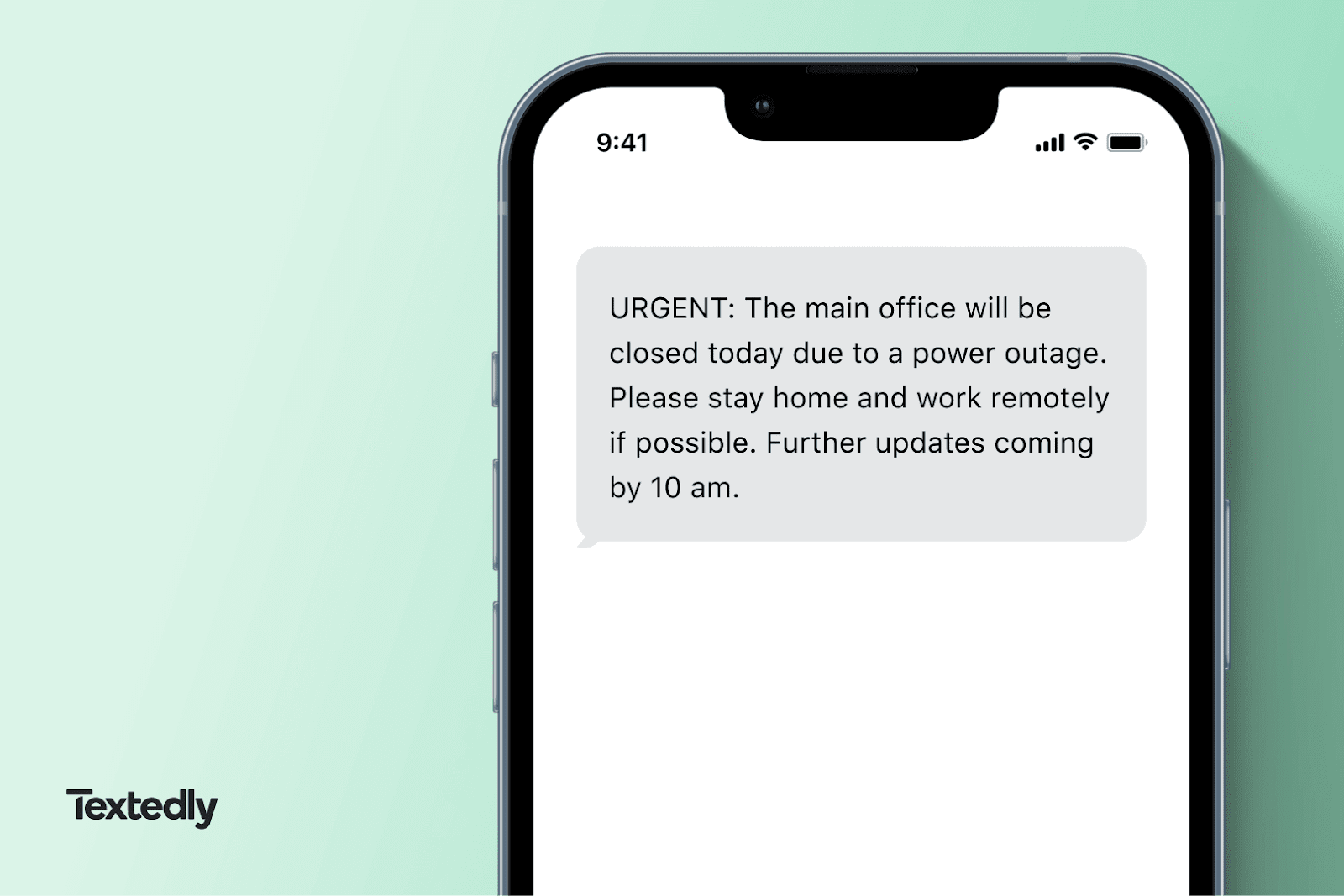In a fast-paced, mobile-first world, businesses can’t afford to let internal communication fall through the cracks. Whether you’re managing a hybrid office or coordinating field staff, effective communication is essential to keep your team in the loop and operations running smoothly.
Yet, traditional channels like email or chat apps often result in missed messages and crossed wires. Emails get buried in overflowing inboxes, logins fail, and employees spend extra time clarifying missed communications. That’s why more organizations are turning to internal SMS as a direct, reliable way to reach their teams, no matter where they are.
In this guide, we’ll teach you everything you need to know about SMS for internal business communications.
Jump right to:
- What is Text Messaging for Internal Communication?
- Is Internal SMS Compliant?
- Why Businesses are Turning to Internal SMS Over Email and Chat
- What Industries Benefit Most From Internal SMS?
- Use Cases for Internal SMS to Improve Workflow
- How to Launch Your Internal SMS Program
<h2 id="What">What is Text Messaging for Internal Communication?</h2>
Internal SMS refers to the use of text messaging to communicate directly with employees or other internal parties, both via a mass text to all employees or on a one-to-one basis with two-way SMS. It’s a flexible solution that allows organizations to send important updates to individual team members or entire departments, without relying on email, chat platforms, or push notifications.
SMS is a valuable tool because it reaches employees directly on their phones, no login or Wi-Fi required. It can be especially useful for colleagues who aren’t always at a desk, dispersed teams, or field workers.
Internal SMS can be leveraged to send:
- Urgent alerts
- Shift changes
- Policy updates
- Security trainings
- Operating closure
- Logistics coordination
- Onboarding flows
<h2 id="Compliant">Is Internal SMS Compliant?</h2>
Yes, with proper consent and security, texting employees is legal. It’s important to understand the compliance basics, best practices, and HR policies you’ll want to keep in place to stay on the right track.
- Get proper opt-in and document employee consent. Clear permission is key for texting employees on personal devices. Collect employee consent to receive job-related text messages.
- Follow HR policies around message storage. Consider how employee messages are logged and control who has access to them.
- Avoid sharing sensitive or personal information. SMS is not the proper channel for private HR matters or confidential data.
- Keep texts respectful and professional. Internal messages should reflect your company’s tone and values. Respect business hours when texting employees and keep communications relevant and to the point.
SMS platforms like Textedly can help your business stay compliant by offering opt-in tools, user permissions, and messaging logs.
<h2 id="Why">Why Businesses are Turning to Internal SMS Over Email and Chat</h2>
As workplace communication becomes more fragmented, with a mix of hybrid, remote, and frontline employees, internal SMS offers a refreshingly simple alternative.
Unlike Slack, Teams, or other chat platforms, SMS doesn’t require an app download, user login, or stable internet connection. It reaches employees wherever they are, making it ideal for mobile-first workers, field staff, or anyone not tied to a desk. Messages are delivered directly to employees’ phones and are more likely to be seen quickly, regardless of location, role, or schedule.
And email, while still important, often suffers from overload. Important announcements can get buried beneath threads, newsletters, and spam. Text messages, on the other hand, boast a 98% open rate, with most messages read within minutes.
From time sensitive alerts to daily reminders, SMS ensures important messages don’t get lost in the shuffle.
<h2 id="Industries">What Industries Benefit Most From Internal SMS?</h2>
Internal SMS works across virtually every industry. Here’s how different industries are leveraging text messaging to improve internal communications and stay aligned.
Retail
Retail teams are often spread across multiple store locations and shifts, making real-time communication a challenge. With internal SMS, managers can instantly notify staff about schedule changes, shift openings, promotional updates, or new product launches.
Plus, teams can streamline coordination during peak sales periods, inventory updates, or unexpected closures, ensuring public-facing teams have the information they need to satisfy customers.
Healthcare
In the healthcare industry, it’s crucial that information be able to travel rapidly. Internal SMS helps hospitals, clinics, and care facilities share urgent updates quickly — whether it’s filling open shifts, coordinating patient care, or notifying staff of emergency situations.
Plus, texting is a HIPAA-compliant tool when used properly, making it ideal for operational messaging that doesn’t include personal health data.
Construction
Construction teams are constantly on the move, at job sites, in transit, or working outdoors with limited access to Wi-Fi. With internal SMS, project managers have a reliable way to communicate site changes, weather delays, safety protocols, and delivery changes in real time.
It’s also a great tool to keep teams up-to-date on mandatory training, inspections, and ever-changing project deadlines, all without needing to download an app or check an email in the field.
Education
For school administrators, SMS simplifies communication with faculty and staff across campuses or even districts. Educators and administrators can leverage SMS to:
- Communicate schedule changes
- Organize professional development activities
- Manage emergency closures
- Coordinate operations and events
- Notify substitute teachers when needed
- Share administrative announcements
Hospitality
From restaurants to hotels and event venues, hospitality organizations rely on fast-paced coordination. Internal SMS makes it easy to send updates about guest arrivals, room changes, event timelines, or last-minute staffing needs.
Managers can use texting to check staff availability, confirm shift assignments, or quickly resolve service issues. Internal SMS helps teams deliver exceptional guest experiences with fewer communication delays.
<h2 id="Use">7 Top Use Cases for Internal SMS</h2>
No matter your industry, internal SMS helps to streamline day-to-day operations and keeps everyone aligned. Let’s look at a few ways SMS automations and workflows can make your communications easy and effective.
1. Company-Wide Updates
Keep everyone aligned with timely announcements, policy changes, or important reminders. SMS ensures that updates reach teams fast, regardless of their working location.

2. Security Trainings
Use SMS to remind employees of upcoming security or compliance sessions. These quick nudges can help boost attendance and reduce follow-up work for HR or IT teams.
Send links directing employees right to training portals to remove access barriers and increase the percentage of on-time training completions.
3. Last-Minute Shift Changes
Need to fill a shift fast? Internal SMS enables managers to contact employees instantly and confirm availability in real time.

4. Event Reminders
Ensure team members don’t forget about upcoming company events, fundraisers, or registration deadlines. A simple reminder text can help to reduce no-shows and improve participation rates while boosting excitement for the event.
5. Payroll Notifications
Let employees know when pay has been processed or send reminders for other HR-related items, such as PTO balances or approved time-off requests.

6. Onboarding Workflows
Automate a welcome series or checklist for new hires to ensure they’re set up for success when they start. Texts can include convenient links to training modules, introductions to team members, or share reminders to complete new-hire paperwork.
7. Crisis Communication
In the event of emergencies, whether it’s a power outage, inclement weather, or urgent facility issues, SMS lets you reach employees quickly and reliably.

<h2 id="How">How to Launch Your Internal SMS Program</h2>
Getting started with internal texting is simple. Here’s how to begin.
- Choose an SMS provider. Your SMS platform should ideally offer mass messaging, workflow automation, and compliance/opt-in tools.
- Get employee consent. Collect consent to text employees in order to remain compliant and transparent.
- Segment your audience. Group employees by department, location, or role for more targeted communication.
- Write clear, concise messages. Get to the point fast and make sure each message communicates clearly an action the employee should take or information they need to know.
- Schedule or trigger texts. Schedule texts to send at key times, such as before events, enrollment renewals, or in case of emergencies.
Textedly users can do all of this — and more — from one user-friendly dashboard.
No Desk? No Problem. Reach Your Teams With SMS.
Slow or inconsistent communication impacts your operations, your culture, and your overall bottom line. Textedly helps solve communication problems by giving you the tools to send fast, effective internal SMS that keeps everyone on the same page.
With features like contact segmentation, scheduled messaging, team collaboration, and built-in automation workflows, internal communication gets even easier with Textedly.
Say goodbye to missed calls, unread emails, crossed wires, and messaging mixups. Keep your team connected through Textedly. Try it for free.






